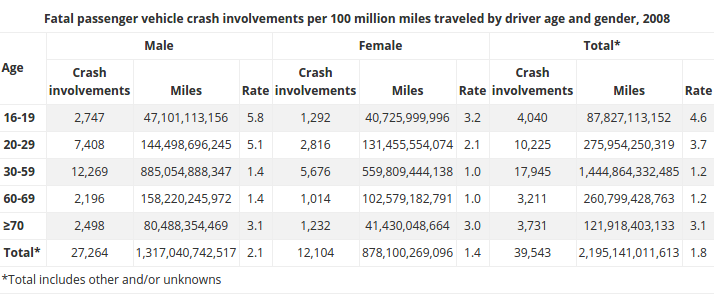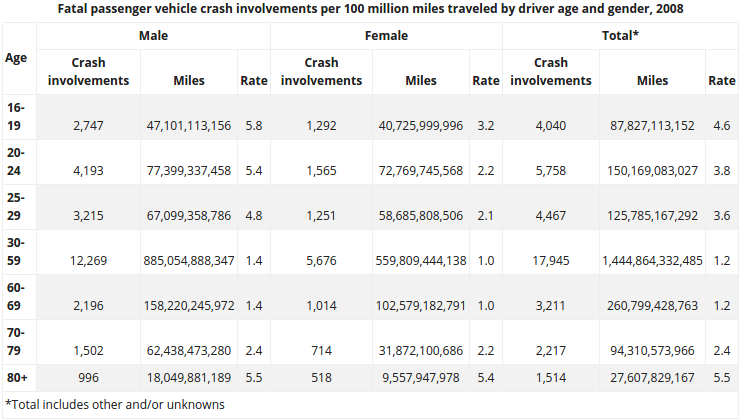More than 30,000 Americans die each year due to auto-related collisions. I started this blog to reduce this number, and am happy to have helped thousands of parents make safer car seat and vehicular choices for their children and families. This has become my life’s work.
Drilling down into the numbers, it becomes apparent, however, that some drivers are more dangerous than others.
How safe are seniors (65+) compared to teenagers?
Earlier I wrote about how the most dangerous drivers on the road, in terms of involvement in fatal collisions per mile traveled, weren’t seniors, as is commonly thought in the US, but actually 16 to 29-year-old male drivers in general, and 16 to 19-year-old male drivers in particular. This information is summarized again here through this IIHS chart:
The chart is a good start, as at first glance, it clearly disproves the notion that senior drivers are our most dangerous on the road. In the United States, citizens are typically classified as seniors once turning 65, as this is when they become eligible for Medicare (and when they used to become fully eligible for Social Security, although this has age of eligibility has unfortunately been scaled up over the years).
 The chart suggests the safest drivers, both male, and female, are those between 30 and 69, or more specifically, between 30 and 59 and between 60 and 69. The 60-69 group clearly involves a number of seniors, yet they still contribute to the group of the safest drivers.
The chart suggests the safest drivers, both male, and female, are those between 30 and 69, or more specifically, between 30 and 59 and between 60 and 69. The 60-69 group clearly involves a number of seniors, yet they still contribute to the group of the safest drivers.
The 70 and over crowd becomes somewhat less safe, but both male and female drivers 70 or older are still less likely to be involved in fatal collisions per mile traveled than men between 16 and 29 and women between 16 and 19. Overall, drivers as a whole 70 and older are safer than drivers as a whole between 16 and 29, primarily due to just how unsafe male drivers are between 16 and 29.
To put it simply, 16-19-year-old teenagers are more likely to be involved in fatal collisions per mile traveled than drivers over 65, regardless of gender.
OK, so seniors 65 and over are safer overall than teenagers. But how safe are seniors 80 and over compared to teenagers?
With this question, the picture becomes a bit more complicated, as information involving large numbers of people tends to be. Let’s split the age cohorts a bit more, adding a category of drivers between 20 and 24, a category of drivers between 25 and 29, a category of drivers between 70 and 79, and a category of drivers 80 and older. Are seniors still going to be universally safer than the average male driver under 30 or the average female driver under 20?
Not quite. Let’s look at another chart of IIHS data that answers this question:
The chart offers more resolution than the other one. Seventy to 79-year-old drivers overall are still safer than 16 to 29-year-olds overall, but as a group, 80 and older drivers become the group most likely to be involved in fatal collisions per mile traveled.
Specifically, male drivers 80 and over are still less likely to be involved in fatal collisions per mile traveled than male 16 to 19-year-olds, who remain the most dangerous age and gender cohort, and almost identical to 20 to 24-year old male drivers. However, because of how safe female drivers are overall–even the 16 to 19-year-old female cohort–the 80 and older female cohort become the most dangerous female cohort, and the overall cohort of 80 and older drivers becomes the most dangerous group on the road.
To put it simply, 16 to 19-year-old teenagers are more likely to be involved in fatal collisions per mile traveled than drivers between 65 and 79, regardless of gender. However, drivers 80 and over are more likely to be involved in fatal collisions than teenagers between 16 and 19, even though drivers 80 and over are still safer than male drivers between 16 and 19 and almost identical to male drivers between 20 and 24.
The problem with this data, though, is that it’s still incomplete. Even though it provides a more detailed look at driver safety than the previous chart, there are still many unanswered questions. For example, where between 70 and 79 does the rate of fatal driver collision involvement show its steepest inflection, or change?
I can’t answer that question right now. But what’s clear from this analysis is that seniors don’t become more dangerous drivers than teenagers until they’re past 80, and even then, they’re still safer than teen males between 16 and 19, and just about as safe as male adults between 20 and 24. Teen males between 16 and 19 remain the most dangerous drivers on the road.
—
If you find the information on car safety, recommended car seats, and car seat reviews on this car seat blog helpful, you can shop through this Amazon link for any purchases, car seat-related or not. Canadians can shop through this link for Canadian purchases.

